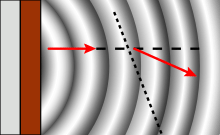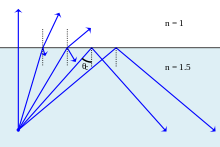Optics/Refraction
< Optics
Refraction is the change in direction and phase velocity of a wave due to a change in the medium in which the wave is traveling. A wave which undergoes this phenomenon is said to have been refracted. This phenomenon is most commonly observed when a wave passes from one medium to another at any angle other than 90° or 0°. Refraction is described by Snell's law (also known as the Snell–Descartes law and the law of refraction), which states that for a given pair of media and a wave with a single frequency, the ratio of the sines of the angle of incidence θ1 and angle of refraction θ2 is equivalent to the ratio of phase velocities (v1 / v2) in the two media, or equivalently, to the opposite ratio of the indices of refraction (n2 / n1):
When a wave travels across an interface and into a medium with a higher index of refraction, the wave bends towards the normal. If a wave travels across an interface and into a lower index of refraction, the wave bends away from the normal. If a wave travels across an interface and into a medium with the same index of refraction, the direction of the wave's propagation does not change. The two most common indices of refraction used when first exploring the topic of refraction are air (n=1.00029) and water (n=1.33). To simplify calculations, the index of refraction of air is typically approximated to be n=1.00 (which is actually the index of refraction of a vacuum).

As the angle of incidence increases, the angle of refraction also increases. There comes a point in which the angle of refraction is 90° and means that the wave refracts parallel to the interface. This angle is called the critical angle and for angles greater than or equal to the critical angle, refraction does not take place and all of the light is reflected; this phenomenon is called total internal reflection and will be covered in the next section.
| Material | λ (nm) | n | Ref. |
|---|---|---|---|
| Vacuum | 1 (per definition) | ||
| Air at STP | 1.000277 | ||
| Gases at 0 °C and 1 atm | |||
| Air | 589.29 | 1.000293 | [1] |
| Carbon dioxide | 589.29 | 1.00045 | [2] |
| Helium | 589.29 | 1.000036 | [1] |
| Hydrogen | 589.29 | 1.000132 | [1] |
| Liquids at 20 °C | |||
| Arsenic trisulfide and sulfur in methylene iodide | 1.9 | [5] | |
| Benzene | 589.29 | 1.501 | [1] |
| Carbon disulfide | 589.29 | 1.628 | [1] |
| Carbon tetrachloride | 589.29 | 1.461 | [1] |
| Ethyl alcohol (ethanol) | 589.29 | 1.361 | [1] |
| Silicone oil | 1.52045 | [6] | |
| Water | 589.29 | 1.3330 | [1] |
| Solids at room temperature | |||
| Titanium dioxide (Rutile phase ) | 589.29 | 2.496 | [7] |
| Diamond | 589.29 | 2.419 | [1] |
| Strontium titanate | 589.29 | 2.41 | |
| Amber | 589.29 | 1.55 | [1] |
| Fused silica (also called Fused Quartz) | 589.29 | 1.458 | [1] |
| Sodium chloride | 589.29 | 1.544 | [8] |
| Other materials | |||
| Liquid helium | 1.025 | ||
| Water ice | 1.31 | ||
| Cornea (human) | 1.373/1.380/1.401 | [9] | |
| Lens (human) | 1.386 - 1.406 | ||
| Acetone | 1.36 | ||
| Ethanol | 1.36 | ||
| Glycerol | 1.4729 | ||
| Bromine | 1.661 | ||
| Teflon AF | 1.315 | [10] | |
| Teflon | 1.35 - 1.38 | ||
| Cytop | 1.34 | [11] | |
| Sylgard 184 | 1.4118 | [12] | |
| PLA | 1.46 | [13] | |
| Acrylic glass | 1.490 - 1.492 | ||
| Polycarbonate | 1.584 - 1.586 | ||
| PMMA | 1.4893 - 1.4899 | ||
| PETg | 1.57 | ||
| PET | 1.5750 | ||
| Crown glass (pure) | 1.50 - 1.54 | ||
| Flint glass (pure) | 1.60 - 1.62 | ||
| Crown glass (impure) | 1.485 - 1.755 | ||
| Flint glass (impure) | 1.523 - 1.925 | ||
| Pyrex (a borosilicate glass) | 1.470 | [14] | |
| Cryolite | 1.338 | ||
| Rock salt | 1.516 | ||
| Sapphire | 1.762–1.778 | ||
| Sugar Solution, 25% | 1.3723 | [15] | |
| Sugar Solution, 50% | 1.4200 | [15] | |
| Sugar Solution, 75% | 1.4774 | [15] | |
| Cubic zirconia | 2.15 - 2.18 | ||
| Potassium Niobate (KNbO3) | 2.28 | ||
| Moissanite | 2.65 - 2.69 | ||
| Cinnabar (Mercury sulfide) | 3.02 | ||
| Gallium(III) phosphide | 3.5 | ||
| Gallium(III) arsenide | 3.927 | ||
| Zinc Oxide | 390 | 2.4 | |
| Germanium | 4.01 | ||
| Silicon | 590 | 3.96 | [16] |
See also
- 1 2 3 4 5 6 7 8 9 10 11 Optics, Fourth Edition. Pearson Higher Education. 18 March 2003. ISBN 978-0-321-18878-6.
- ↑ Introduction to Geometrical and Physical Optics. McGraw-Hill Book Company, INC.. 1953.
- ↑ Handbook of Chemistry and Physics. Chemical Rubber Publishing Co.. 1957.
- ↑ Introduction to Optics, Third Edition. Pearson Prentice Hall. 2007. p. 221. ISBN 0-13-149933-5.
- ↑ Meyrowitz, R, A compilation and classification of immersion media of high index of refraction, American Mineralogist 40: 398 (1955)
- ↑ Silicon and Oil Refractive Index Standards
- ↑ RefractiveIndex.INFO - Refractive index and related constants
- ↑ College Physics, 6th Edition. Brooks/Cole. 2003. p. 692. ISBN 978-0-03-035114-3.
- ↑ "Refractive index of the human corneal epithelium and stroma". J Refract Surg. 11 (2): 100–105. 1995 Mar-Apr. PMID 7634138.
- ↑ "Teflon AF". http://www2.dupont.com/Teflon_Industrial/en_US/products/product_by_name/teflon_af/properties.html. Retrieved 2010-10-14.
- ↑ "Cytop". http://www.agcce.eu.com/CYTOP/TechInfo.asp. Retrieved 2010-10-14.
- ↑ "184 Silicone Elastomer" (PDF). Dow Corning. Archived from the original on 2013-03-14. http://web.archive.org/web/20130314075539/http://www1.dowcorning.com/DataFiles/090007c8802d7bc4.pdf. Retrieved 2012-12-11.
- ↑ "Poly(Lactic Acid): Synthesis, Structures, Properties, Processing, and Applications; Chapter 8: Optical Properties". http://onlinelibrary.wiley.com/doi/10.1002/9780470649848.ch8. Retrieved 2012-10-25.
- ↑ University of Liverpool. "Absolute Refractive Index". http://www.matter.org.uk/schools/Content/Refraction/absolute.html. Retrieved 2007-10-18.
- 1 2 3 "Manual for Sugar solution Prism". http://www.frederiksen.eu/fileadmin/user_upload/PDF/Export_Manuals/545920_AE_sugarsolution.pdf. Retrieved 2012-3-21.
- ↑ "Optical Properties of Silicon". http://pvcdrom.pveducation.org/APPEND/OPTICAL.HTM. Retrieved 2009-05-31.
